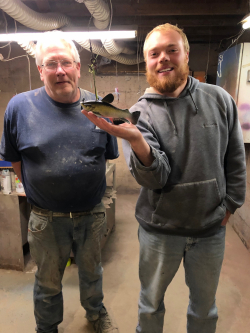
Walker Bruns began his fishing tackle business called Bruns Tackle while he was in the 8th Grade. He was assigned a school project to create a mock business including a product, pricing, and a full business plan. Six years later, his business is thriving, he is a graduate from North Dakota State University with a degree in Business Administration, a minor in Entrepreneurship, and has a whole new skill set of creating spearfish decoys thanks to the NDCA Folk and Traditional Arts Apprenticeship Program.

NDCA Folklorist Troyd Geist caught wind of Bruns Tackle and contacted Walker about the Folk and Traditional Arts Apprenticeship Program which, “honors and encourages the preservation of North Dakota’s diverse living traditions by providing funding for master traditional artists to pass their skills and knowledge on to apprentices over an extended period of time.”
When Walker heard that he could possibly learn a new skill making spearfish decoys from two of the best crafters in the area, Rick and Connie Whittier of Lidgerwood, ND, he was quick to apply to the program and his application was chosen in 2019. He explained that he not only learned a new skill, he also “developed a greater appreciation for spearing decoys and their history.” The art of making the decoys did not begin with Rick and Connie and will not end with Walker. He said, “they are a piece of functioning art that was made generations ago and is still being made and perfected today.” Walker went on to say that he also “gained two pretty cool friends and mentors. The Whittiers always make time to talk to me and are always quick to answer questions and offer advice when carving new projects.”
 After his time in the apprenticeship program, Walker has changed the way he deals with new tasks and roadblocks. He said the experience taught him to “never turn down an opportunity to learn. There have been numerous new fish species I have been asked to carve and I didn’t have the first clue where to start.” But now he follows a process of researching each new fish, experimenting with colors on pieces of wood or cardboard, and ending with artwork that even impresses the Whittiers! Walker said he would recommend the apprenticeship program to anyone willing to “step outside of their comfort zone and learn a new skill that could be essential to keeping folk arts alive.”
After his time in the apprenticeship program, Walker has changed the way he deals with new tasks and roadblocks. He said the experience taught him to “never turn down an opportunity to learn. There have been numerous new fish species I have been asked to carve and I didn’t have the first clue where to start.” But now he follows a process of researching each new fish, experimenting with colors on pieces of wood or cardboard, and ending with artwork that even impresses the Whittiers! Walker said he would recommend the apprenticeship program to anyone willing to “step outside of their comfort zone and learn a new skill that could be essential to keeping folk arts alive.”
To learn more, including how to apply, visit NDCA’s Folk and Traditional Arts Apprenticeship Program webpage.
By Rhea C. Beto
